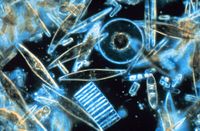
The contribution of aqueous catechol-silica complexes to silicification during carbonate diagenesis
Sign Up to like & getrecommendations! Published in 2020 at "Geochimica et Cosmochimica Acta"
DOI: 10.1016/j.gca.2020.04.016
Abstract: Abstract Pore-filling and carbonate-replacing silica is exceedingly common in carbonates, but the fundamental geochemical mechanisms that drive these silicification reactions during diagenesis remain poorly understood. An existing model has proposed that carbonate silicification proceeds through… read more here.
Keywords: silicification; silica; organo silica; silica complexes ... See more keywords

Intracellular silicification by early-branching magnetotactic bacteria
Sign Up to like & getrecommendations! Published in 2022 at "Science Advances"
DOI: 10.1126/sciadv.abn6045
Abstract: Biosilicification—the formation of biological structures composed of silica—has a wide distribution among eukaryotes; it plays a major role in global biogeochemical cycles, and has driven the decline of dissolved silicon in the oceans through geological… read more here.
Keywords: silicification; early branching; magnetotactic bacteria; intracellular silicification ... See more keywords

Biologically mediated silicification of marine cyanobacteria and implications for the Proterozoic fossil record
Sign Up to like & getrecommendations! Published in 2020 at "Geology"
DOI: 10.1130/g47394.1
Abstract: Silicification was a major mode of fossilization in Proterozoic peritidal environments, but marine silica concentrations and the chemical and biological mechanisms that drove microbial silicification and formation of early diagenetic chert in these environments remain… read more here.
Keywords: marine cyanobacteria; silicification; fossil; mediated silicification ... See more keywords

Understanding Diatom Cell Wall Silicification—Moving Forward
Sign Up to like & getrecommendations! Published in 2018 at "Frontiers in Marine Science"
DOI: 10.3389/fmars.2018.00125
Abstract: The silicified cell walls of diatoms have inspired the interest of researchers for several centuries, and our understanding of their properties and formation has developed in synch with the development of observational and analytical techniques.… read more here.
Keywords: cell wall; silicification; wall silicification; diatom cell ... See more keywords

Integrative effects of morphology, silicification, and light on diatom vertical movements
Sign Up to like & getrecommendations! Published in 2023 at "Frontiers in Plant Science"
DOI: 10.3389/fpls.2023.1143998
Abstract: Diatoms represent the most abundant and diversified class of primary producers in present oceans; their distinctive trait is the ability to incorporate silicic acid in a silica outer shell called frustule. Numerous adaptative functions are… read more here.
Keywords: silicification; light diatom; vertical movements; integrative effects ... See more keywords

Silicification of Wood: An Overview
Sign Up to like & getrecommendations! Published in 2023 at "Minerals"
DOI: 10.3390/min13020206
Abstract: For many decades, wood silicification has been viewed as a relatively simple process of permineralization that occurs when silica dissolved in groundwater precipitates to fill vacant spaces within the porous tissue. The presence of specific… read more here.
Keywords: wood overview; wood; silicification wood; silicification ... See more keywords

Pseudo-Karst Silicification Related to Late Ni Reworking in New Caledonia
Sign Up to like & getrecommendations! Published in 2023 at "Minerals"
DOI: 10.3390/min13040518
Abstract: Silicification in New Caledonian pseudo-karsts developed on peridotite was assessed using δ18O and δ30Si pairs on quartz cements. The objective was to document the chronology of pseudo-karst development and cementation relative to geomorphic evolution. The… read more here.
Keywords: pseudo karst; karst silicification; silicification related; silicification ... See more keywords

SILICIFICATION OF HYDROTHERMAL GANGUE MINERALS IN Pb-Zn-Cu-FLUORITE-QUARTZ-BARYTE VEINS
Sign Up to like & getrecommendations! Published in 2017 at "Canadian Mineralogist"
DOI: 10.3749/canmin.1700005
Abstract: Abstract Late-stage pseudomorphous and perimorphous replacement of euhedral baryte and, to a lesser extent, fluorite and calcite by quartz is a common phenomenon in hydrothermal vein-type deposits. As a consequence of silicification, the primary mineral… read more here.
Keywords: replacement; silicification; baryte; fluorite calcite ... See more keywords